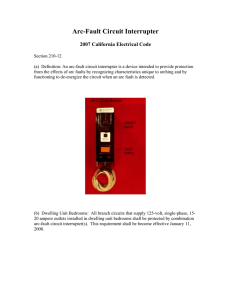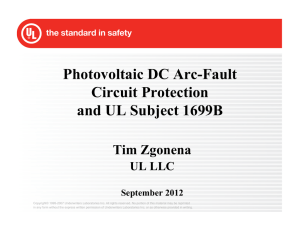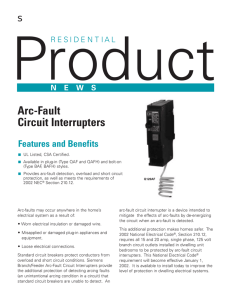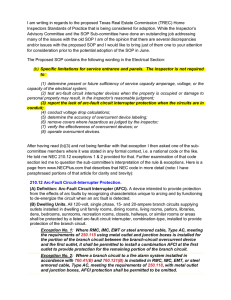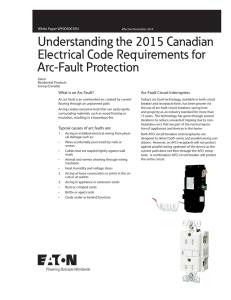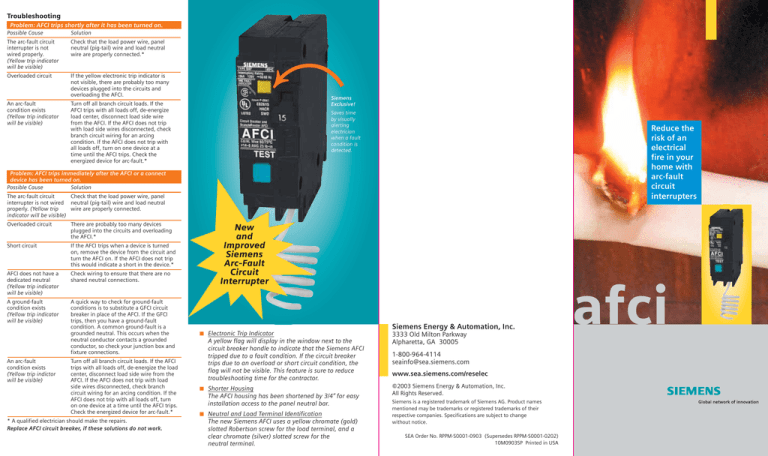
Troubleshooting
Problem: AFCI trips shortly after it has been turned on.
Possible Cause
Solution
The arc-fault circuit
interrupter is not
wired properly.
(Yellow trip indicator
will be visible)
Check that the load power wire, panel
neutral (pig-tail) wire and load neutral
wire are properly connected.*
Overloaded circuit
If the yellow electronic trip indicator is
not visible, there are probably too many
devices plugged into the circuits and
overloading the AFCI.
An arc-fault
condition exists
(Yellow trip indicator
will be visible)
Turn off all branch circuit loads. If the
AFCI trips with all loads off, de-energize
load center, disconnect load side wire
from the AFCI. If the AFCI does not trip
with load side wires disconnected, check
branch circuit wiring for an arcing
condition. If the AFCI does not trip with
all loads off, turn on one device at a
time until the AFCI trips. Check the
energized device for arc-fault.*
Siemens
Exclusive!
Saves time
by visually
alerting
electrician
when a fault
condition is
detected.
Reduce the
risk of an
electrical
fire in your
home with
arc-fault
circuit
interrupters
Problem: AFCI trips immediately after the AFCI or a connect
device has been turned on.
Possible Cause
Solution
The arc-fault circuit
Check that the load power wire, panel
interrupter is not wired neutral (pig-tail) wire and load neutral
properly. (Yellow trip
wire are properly connected.
indicator will be visible)
Overloaded circuit
There are probably too many devices
plugged into the circuits and overloading
the AFCI.*
Short circuit
If the AFCI trips when a device is turned
on, remove the device from the circuit and
turn the AFCI on. If the AFCI does not trip
this would indicate a short in the device.*
AFCI does not have a
dedicated neutral
(Yellow trip indicator
will be visible)
Check wiring to ensure that there are no
shared neutral connections.
A ground-fault
condition exists
(Yellow trip indicator
will be visible)
A quick way to check for ground-fault
conditions is to substitute a GFCI circuit
breaker in place of the AFCI. If the GFCI
trips, then you have a ground-fault
condition. A common ground-fault is a
grounded neutral. This occurs when the
neutral conductor contacts a grounded
conductor, so check your junction box and
fixture connections.
An arc-fault
condition exists
(Yellow trip indictor
will be visible)
Turn off all branch circuit loads. If the AFCI
trips with all loads off, de-energize the load
center, disconnect load side wire from the
AFCI. If the AFCI does not trip with load
side wires disconnected, check branch
circuit wiring for an arcing condition. If the
AFCI does not trip with all loads off, turn
on one device at a time until the AFCI trips.
Check the energized device for arc-fault.*
* A qualified electrician should make the repairs.
Replace AFCI circuit breaker, if these solutions do not work.
New
and
Improved
Siemens
Arc-Fault
Circuit
Interrupter
Electronic Trip Indicator
A yellow flag will display in the window next to the
circuit breaker handle to indicate that the Siemens AFCI
tripped due to a fault condition. If the circuit breaker
trips due to an overload or short circuit condition, the
flag will not be visible. This feature is sure to reduce
troubleshooting time for the contractor.
Shorter Housing
The AFCI housing has been shortened by 3/4” for easy
installation access to the panel neutral bar.
Neutral and Load Terminal Identification
The new Siemens AFCI uses a yellow chromate (gold)
slotted Robertson screw for the load terminal, and a
clear chromate (silver) slotted screw for the
neutral terminal.
Siemens Energy & Automation, Inc.
3333 Old Milton Parkway
Alpharetta, GA 30005
1-800-964-4114
seainfo@sea.siemens.com
www.sea.siemens.com/reselec
2003 Siemens Energy & Automation, Inc.
All Rights Reserved.
Siemens is a registered trademark of Siemens AG. Product names
mentioned may be trademarks or registered trademarks of their
respective companies. Specifications are subject to change
without notice.
SEA Order No. RPPM-S0001-0903 (Supersedes RPPM-S0001-0202)
10M0903SP Printed in USA
afci
What Is An Arc-Fault?
An arc-fault is an unintentional discharge of electricity in
a circuit. Arcing exists in two basic varieties:
natural, or normal occurring arcing
occur when a light is switched on or a vacuum
cleaner or any motor driven appliance is turned on,
and
unsafe arc-faults
occur either as series or parallel faults in wire,
electrical devices or connected loads
Arcing faults, which can and generally do go undetected,
can reach extraordinarily high temperatures–upwards
of 9,000 degrees Fahrenheit.
Problems in home
The heating of surrounding
wiring, like arcing
materials creates a carbon
and sparking, are
remnant that acts as a
associated with more
than 40,000 home
high impedance conductor.
fires each year. These
As the carbon path extends,
fires claim over 350
the by-products of the
lives and injure 1,400
arc increase the available
victims annually.
Consumer Product
fuel source, magnifying
Safety Review, Volume 4,
the likelihood
Summer 1999
of a fire.
What Causes An Arc-Fault?
Arc-faults may occur anywhere in the home’s electrical
system as a result of:
Worn electrical insulation or damaged wire
Misapplied or damaged plug-in appliance cords
and equipment
Loose electrical connections
Accidentally piercing electrical cable behind
drywalls with drill bit, nail or screw
Hammering electrical cable staples too tightly into
studs during rough wiring
Natural aging and cord exposure to heat vents,
sunlight, or foot traffic
What Are Arc-Fault Circuit Interrupters (AFCIs)?
When an unwanted arcing condition is detected, an
AFCI de-energizes the circuit, and reduces the potential
for a fire to occur.
Sputtering Arc From Cut Electrical Cord
Traditional circuit breakers are only intended to respond
to overloads and short circuits. Ground-fault circuit
interrupters (GFCIs) are an effective means of preventing
severe electrical shock by detecting loss of current in a
circuit, but do not protect against arcing conditions that
produce erratic current flow. An AFCI provides a new
level of protection not offered by either of these devices.
How Do AFCIs Work?
Siemens AFCIs employ electronic circuitry to continuously
monitor the circuit and detect the unique characteristics
of arcing. Arc-faults are identifiable by the interruption of
current in a circuit. This interruption will be displayed as
“shoulders” in the current waveform.
Characteristics Of Arcing Current
Shoulders
Normal Current
Voltage
Current
What About Nuisance Tripping?
Connected loads, such as fluorescent lighting, motors,
dimmers and switches, may have inherent arcing as a
normal mode of operation. The Siemens AFCI is
designed to distinguish these arcing faults from
hazardous arcing faults by monitoring the intensity,
duration, and frequency of the arcing fault.
Vacuum Cleaner
Arcing Condition
Arcing often occurs intermittently in each half cycle
of the voltage waveform. The complex arcing event
causes sputtering arcs that vary the current from
normal load patterns.
There are many
causes for arc-faults,
and the results can
be disastrous
Dimmer
NEC Requirements
Requirements of the 1999 National Electrical Code
Article 210-12 (B):
“Dwelling Unit Bedrooms. All branch circuits that
supply 125 volt, single phase, 15 and 20 ampere
receptacle outlets installed in dwelling unit
bedrooms shall be protected by an arc-fault circuit
interrupter(s).”
Requirements of the 2002 National Electrical Code
Article 210-12 (B):
“Dwelling Unit Bedrooms. All branch circuits that
supply 125 volt, single phase, 15 and 20 ampere
receptacle outlets installed in dwelling unit
bedrooms shall be protected by an arc-fault circuit
interrupter listed to provide protection of the entire
branch circuit.”
Analysis of the change–extends arc-fault circuit
interrupter protection to all outlets in dwelling
bedrooms, as well as requiring protection of the
entire branch circuit.
Check with your local authority to confirm
requirements in your area.
Technical Specifications
Siemens AFCI circuit breakers are UL listed per
Standard 1699 and meet the requirements of the
National Electrical Code Section 210-12. These
devices provide the normal overload and short circuit
protection that all circuit breakers provide and in
addition they provide the added protection against
arc faults.
Other Applications
You should also consider adding AFCI protection to
existing homes. Older homes with standard circuit
breakers may benefit from the added detection of
arcing that can occur in aging electrical systems.
Siemens AFCI circuit breakers easily replace any single
pole 15 or 20 amp circuit breaker in the load center.
Siemens AFCIs have been tested with a wide variety
of products, including fluorescent lights, hand drills,
vacuum cleaners, hair dryers, dimmers, and other
appliances containing electric motors to make sure
they will not nuisance trip and the loads do not mask
the presence of an arc.
Selection Information
1-Pole, 120V AC, 60 Hz
Ampere Catalog
Rating
Number
AIC
Std. Master Std. Master
Ctn. Qty.
Ctn. Wt.
Wire
Range
Plug-In AFCIs
15
Q115AF
15
Q115AFH
20
Q120AF
20
Q120AFH
10K
22K
10K
22K
1/10
1/10
1/10
1/10
#14-#8
#14-#8
#14-#8
#14-#8
.5/15
.5/15
.5/15
.5/15
NEC and National Electrical Code are registered trademarks of the
National Fire Protection Association.

